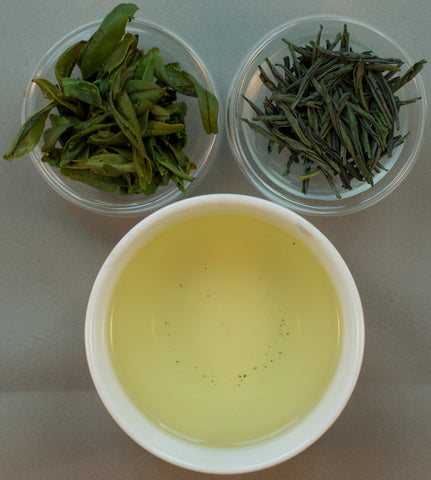One of the quintessential Chinese green teas, Long Jing is known for it’s jade color, vegetal aroma, singular flattened leaf shape, and mellow flavor. While the “famous” Long Jing comes from the National Protected Zone in the West Lake Region of Hangzhou in Zhejiang province, much Long Jing is now produced outside the traditional West Lake region. Some of it might be from one of the Long Jing cultivars growing outside the traditional area, some of it will use the modern commercial Long Jing #43 cultivar developed to flush earlier so as to more easily make the pre-Qing Ming premium value window, and some of it will be non-Long Jing cultivars produced in the Long Jing “style”. If produced with care in an appropriate terroir, they can all be delicious.
This Long Jing uses a traditional varietal and is grown in Chayuen Village in Gansu. Chayuen is a remote village with a terroir appropriate for the growing of specialty tea. The village contains about 150 households and 150 people and was devastated in the 2008 Sichuan Earthquake. The 7.9 magnitude quake destroyed houses, roads and the land itself. The continued cultivation of specialty tea is one way the village continues to recover. The nearby Minshan mountains include parts of the Giant Panda Nature Reserve.
Provenance:
-
Origin: Chayuen Village, Gansu Province, China
-
Grower/Teamaster: Chayuen Village Co-op
-
Harvest Date: Late March, 2018 (Pre-Qing Ming)
-
Cultivar: Long Jing varietal (probably Changye) brought from West Lake area in Hangzhou. It is not the modern Longjing #43 cultivar.3
-
Cultivation: Seasonal Conventional
-
Plucking Standard: Bud pluck.
-
Processing Notes: Traditional pan-fired
-
Nickname: Dragonwell
-
History/Pedigree: One of China’s 10 most famous teas. The West Lake region is the origin of the Long Jing style. The famous and most authentic Long Jing comes from the National Designated Protection Zone in West Lake. The villages within this zone are Wengjiashan, Longjing, Shifeng, and Meijiawu. It is usually prohibitively expensive and consumed inside of China. Most Long Jing teas on the global market are the modern Long Jing #43 cultivar, developed to flush earlier and grow all over China to meet the demand for Long Jing.
Brewing Suggestions1:
-
Water: 175-185˚F filtered water
-
Tea: 2g per 4oz of water (about a scant 1 TB2)
-
Steep: 2 minutes with 2-4 additional steepings.
Tasting Notes:
This Long Jing is sweet, nutty, and fresh, with a clean mineral finish and a softly sparkling texture. The aftertaste lingers with a soft aroma and a sweet flavor. An elegant and complex Long Jing.
1 Brewing suggestions are just that. Try it as suggested, and then experiment. In this case I suggest first experimenting with the length and number of steepings. You could also experiment with the quantity of tea per oz of water. For temperature, 175˚ gives a sweeter, lighter profile while 185˚ is more buttery and vegetal. Some tea drinkers like to use slightly hotter and longer times for each subsequent steeping.
2 Weighing your tea is always the best way to control your dosage. I provide approximate volume measures for convenience but they can be problematic due to the variance in tea leaf shape and size.
3 Life in a Teacup has a reference to a Long Jing Jiu Keng Group cultivar and also to a Long Leaf cultivar. They refer to Long Jing Jiu Keng as the “traditional” cultivar. Interestingly, they also believe “cultivar overrules harvest date and production region”



